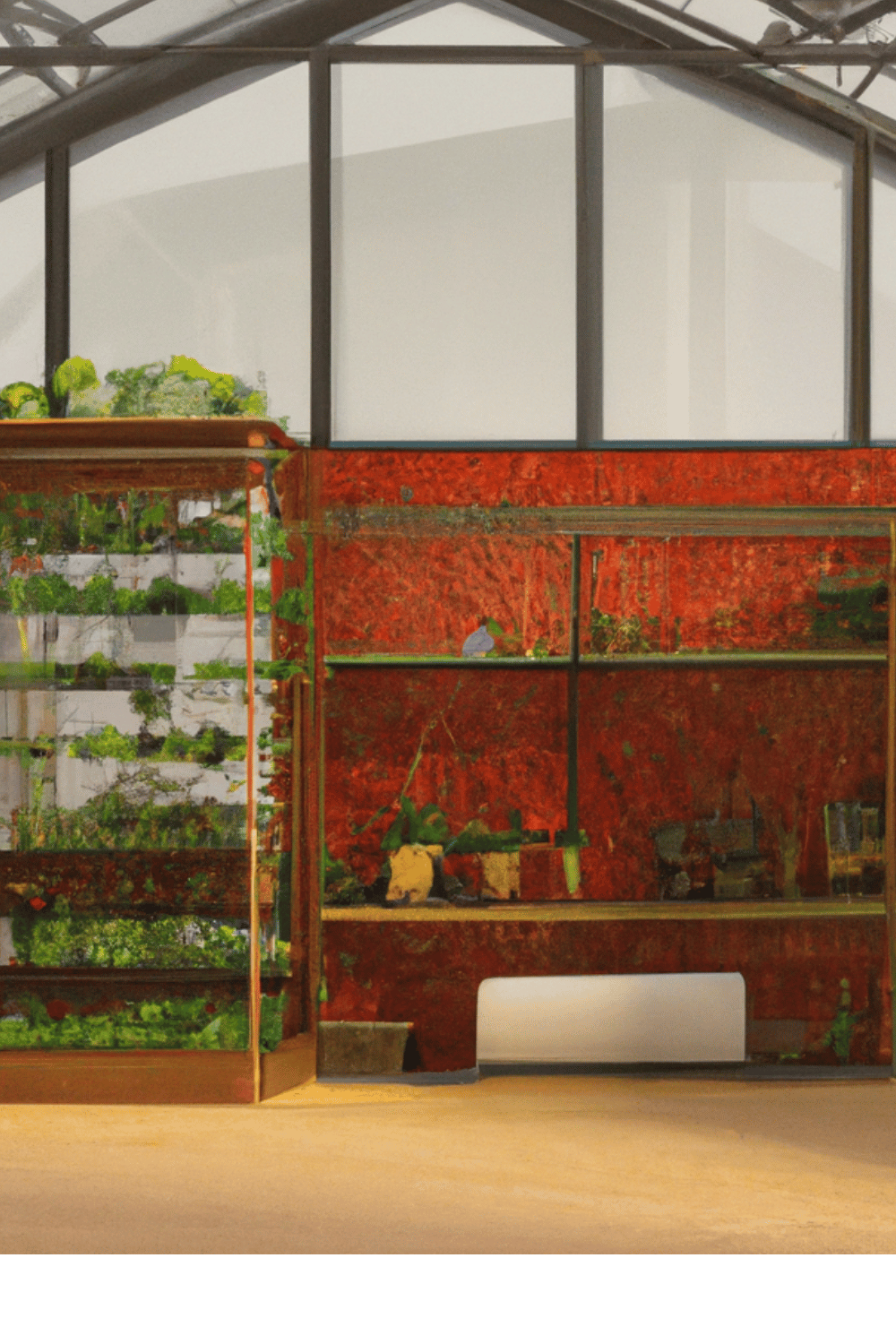Introduction
Who hasn’t dreamed of their very own lush garden? Whether it’s city living, a concrete jungle, or the harsh whims of Mother Nature holding you back, there’s a perfect solution – the indoor greenhouse! It’s more than just a gardening tool; it’s a ticket to a thriving indoor garden regardless of location or weather. An indoor greenhouse is your private sanctuary where you can nourish and grow your favorite plants all year round. As a bonus, you’re also taking the first steps toward a self sustaining home!
Understanding an Indoor Greenhouse
An indoor greenhouse, as the name suggests, is a greenhouse that you can set up right inside your home. It’s your personal haven, filled with your favorite plants. Whether you’ve got space for a small tabletop setup, a dedicated room, or something in between, an indoor greenhouse adapts to your needs, allowing you to bring the joys of gardening right inside your living space. It’s like having your very own botanic garden, with the added benefit of climate control!
The Benefits of an Indoor Greenhouse
Year-round Gardening
Imagine a winter garden that remains vibrant and lively even while it snows outside or a summer garden thriving in the middle of a city. With an indoor greenhouse, the weather will never dictate your gardening schedule again. You’re free to grow, prune, and harvest all year round. The seasons can change, but your love for gardening doesn’t have to!
Protection from Pests
Pesky aphids, caterpillars, and slugs can destroy an outdoor garden in no time. An indoor greenhouse safeguards your precious plants from these common pests, providing them with a safe and secure environment to grow and flourish. With an indoor greenhouse, you’re not just a gardener but also a protector, keeping your plants safe from harm.
Climate Control
With an indoor greenhouse, you are the master of your garden’s climate. Temperature, humidity, light conditions—you can control it all. This means you can cultivate a much broader variety of plants than in an outdoor setting. If you’ve always dreamt of growing a tropical plant but live in a cold climate, an indoor greenhouse makes that dream a reality!
Setting Up Your Indoor Greenhouse
Choosing the Right Location
Factors to Consider
Light availability, temperature, and space are the most crucial factors in choosing a location for your indoor greenhouse. While natural light is ideal, innovative solutions for artificial lighting make it possible to establish a greenhouse even in the darkest corners of your home. With an indoor greenhouse, you’re the interior designer of your garden, selecting the perfect spot for your plants to thrive.
Types of Indoor Greenhouses
Mini Greenhouses
Perfect for beginners or those with limited space, mini greenhouses are small, compact, and can comfortably sit on a tabletop. Picture your morning coffee next to a lush garden thriving in your living room. Sounds delightful, right? It’s the perfect way to bring a touch of nature to your everyday life.
Lean-to Greenhouses
Lean-to greenhouses are larger than mini-greenhouses, and designed to lean against a wall or a fence. If you’re lucky enough to have some outdoor space, these greenhouses create a seamless transition between your indoor and outdoor gardens. They’re like an extension of your home, bridging the gap between the indoors and outdoors.
Free-standing Greenhouses
Free-standing greenhouses are standalone structures that offer the most space for your plants. Picture a room bathed in sunlight, teeming with your favorite plants—a perfect sanctuary from the hustle and bustle of daily life. It’s like having your very own secret garden, where you can escape the world and immerse yourself in the tranquility of nature.
Managing Your Indoor Greenhouse
Plant Selection
Choosing the Right Plants
Choosing the right plants for your indoor greenhouse is like casting actors for a play—you need the right characters to create the perfect story. Some good options for an indoor greenhouse include succulents, ferns, herbs, indoor vine plants, and even some fruit-bearing plants. With a bit of research and some trial and error, you’ll discover which plants best suit your indoor environment and personal preference.
Light, Temperature, and Humidity
Creating the Perfect Conditions
Creating the perfect conditions in your indoor greenhouse is like being a meteorologist, only instead of predicting the weather, you control it! By managing light, temperature, and humidity, you can recreate the ideal growing conditions for your chosen plants. It’s all about striking the perfect balance. Too much light or heat can be as detrimental as too little. As Goldilocks would say, it needs to be just right!
Temperature and Humidity Management
Tools for Managing Climate
There are several tools available to help you manage temperature and humidity. From heaters and fans to humidifiers and dehumidifiers, there’s a solution for every climate challenge. Remember, happy plants make a happy gardener!
Troubleshooting Common Issues
Dealing with Plant Diseases
Common Indoor Greenhouse Plant Diseases
Despite our best efforts, sometimes plants do fall ill. The key is to diagnose and treat the issue as soon as possible. Common diseases include powdery mildew, leaf spot, and root rot. If you notice any signs of these, it’s time to play doctor!
Managing Overcrowding
Overcrowding can lead to a lack of air circulation and increase the chances of disease. It’s like being packed in a crowded bus during rush hour—not fun! Make sure each plant has its space.
Managing Inadequate Ventilation
Speaking of air circulation, ensuring your indoor greenhouse is well-ventilated is important. You can use fans to help with this. Remember, plants, like people, need to breathe!
The Aesthetics of Indoor Greenhouses
Incorporating an Indoor Greenhouse into Your Home Design
An indoor greenhouse isn’t just functional—it can also add to the aesthetics of your home. With the right design, it can be a living piece of art, a stunning focal point that sparks conversations.
Extending Your Indoor Greenhouse
Propagating Your Plants
A Beginner’s Guide to Propagation
If your indoor greenhouse is thriving, and you’re thinking, “What’s next?”—allow me to introduce you to propagation. Propagation is like cloning your plants. It sounds complex, but it’s actually pretty simple. By propagating your plants, you can expand your indoor garden without spending a fortune on new plants. Let’s dive into a beginner’s guide to propagation and unlock the secret to plant multiplication.
Propagation methods can vary depending on the type of plant, but there are a few common techniques you can explore:
- Stem Cutting: This is one of the most popular and straightforward propagation methods. Take a healthy stem from a mature plant, typically a few inches long, and make a clean cut just below a node. Remove any lower leaves, as they might rot when placed in water or soil. Place the cutting in a glass of water or a well-draining soil mix, ensuring the node is submerged or inserted into the soil. Keep the cutting in a warm and humid environment, and you’ll notice roots forming in a few weeks. Once the roots are well-developed, you can transfer the cutting to its own pot and watch it grow into a new plant.
- Leaf Cutting: Leaf cuttings are ideal for plants with succulent leaves, such as jade plants or certain types of begonias. Gently remove a healthy leaf from the parent plant, including a small section of the stem attached to it. Allow the leaf cutting to dry and callus over for a day or two. Then, place the leaf on top of a well-draining soil mix, ensuring the cut end is slightly buried. Mist the soil to maintain moisture and place the container in a warm location with indirect light. Over time, small plantlets will emerge from the base of the leaf, indicating successful propagation. You can then transplant these new plantlets into individual pots.
- Division: Division is a propagation technique suitable for plants that naturally produce multiple stems or have a clumping growth habit. Carefully remove the plant from its pot and gently separate the root ball into two or more sections, ensuring each has its own roots and stems. Plant each divided section into its own pot, ensuring adequate soil and water. This method allows you to rejuvenate crowded plants and multiply your indoor garden simultaneously.
Remember, not all plants can be propagated using the same techniques. Some plants, such as spider plants and pothos, can be propagated in water, while others prefer a soil medium right from the start. It’s important to research the specific propagation methods that work best for the plants you want to propagate.
Propagation is a cost-effective way to expand your indoor garden and a rewarding process. Watching new roots sprout, and young shoots emerge from cuttings can bring a sense of accomplishment and connection with nature. Plus, you’ll have extra plants to share with friends or even start your own plant-swap community.
So, don’t be afraid to give propagation a try. With a bit of patience, practice, and a dash of green-thumb magic, you’ll become a propagation pro in no time. Happy propagating!
Advanced Indoor Greenhouse Ideas
Exotic Plants You Can Try
If you’re up for a challenge, how about trying your hand at some exotic plants? Ever heard of a Pitcher Plant? This carnivorous plant is a sight to behold with its unique shape and vibrant colors. And it eats bugs, so that’s an added pest control bonus! Or how about a Bird of Paradise? Named for its stunning flowers that resemble a bird in flight, this plant can bring a tropical vibe to your indoor greenhouse. And let’s not forget orchids. There’s a reason these elegant and stunning flowers are so loved. They might require a bit more care, but their breathtaking blooms are worth it.
Turn Your Hobby into a Business
Selling Your Plants
If your indoor greenhouse is thriving and you’ve mastered propagation, you might find yourself with more plants than you need. Why not turn this into an opportunity? You can sell your plants online or at a local farmers market. It’s a great way to share the joy of gardening with others and make a bit of money from your hobby. And let’s face it, who wouldn’t love to buy a plant grown with your tender love and care?
Conclusion
Having an indoor greenhouse is like embarking on a journey of constant learning, growth, and joy. It’s not just about growing plants; it’s about cultivating patience, nurturing life, and reaping the rewards of your hard work. So, what are you waiting for? Go ahead and start your indoor greenhouse today. Happy gardening!
FAQs
- What is an indoor greenhouse? An indoor greenhouse is a space in your home where you can grow plants under controlled conditions all year round.
- How much time does it take to maintain an indoor greenhouse? The amount of time it takes to maintain an indoor greenhouse depends on the size of the greenhouse and the types of plants you’re growing. Generally, a few minutes each day can suffice.
- Can I grow any type of plant in my indoor greenhouse? While you can grow a wide variety of plants in an indoor greenhouse, it’s best to choose plants suited to your greenhouse’s specific conditions.
- Do I need to use any special soil type for my indoor greenhouse? The type of soil you need depends on the plants you’re growing. Some plants prefer a more acidic soil, while others prefer a more neutral pH.
- Can I start an indoor greenhouse even if I’m a beginner? Absolutely! Everyone starts somewhere. With a bit of patience, learning, and a love for plants, anyone can start an indoor greenhouse.




Pingback: Self Sustaining Homes: A Definitive Guide to the Exciting Future
Pingback: Composting 101: In the (Sustainable and Eco Friendly) Beginning
Pingback: Building Off the Grid: A Guide to a Self-Sustained Lifestyle
Pingback: Eco Friendly Toilet Paper: A Cheeky Guide to Going Green
Pingback: How to Make Compost: A Guide to a Greener Garden
Pingback: Organic Soap: A Deep Dive into the World of Natural Cleanliness - Eco Life Wise
Pingback: Organic Soap: A Deep Dive into the World of Natural Cleanliness | Eco Life Wise
Pingback: Composting Worms: The Unsung Heroes of Your Garden *
Pingback: Mushroom Compost: Care for Some Black Gold? | Eco Life Wise
Pingback: Sustainable Packaging: Unlocking Eco Friendly Solutions | Eco Life Wise
Pingback: Organic Nails: Unearthing the Ultimate Guide to Natural Nail Art | Eco Life Wise
Pingback: How to Live Off the Grid: Your Ultimate Guide
Pingback: BPJECT Compost Spreader Peat Moss Spreader 24inch Review | Eco Life Wise